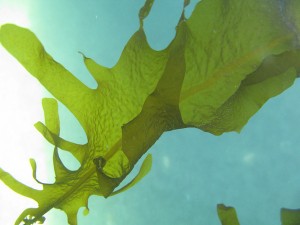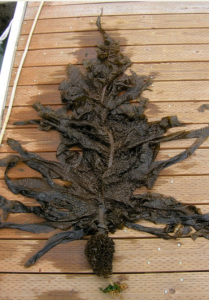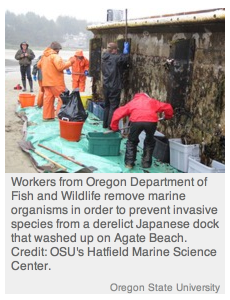 Undaria pinnatifida
Undaria pinnatifidaNative range: Japan Sea
Invasive range: Southern California, San Francisco Bay, New Zealand, Australia, Europe, Argentina
Habitat: Opportunistic seaweed, can be found on hard substrates including rocky reefs, pylons, buoys, boat hulls, and abalone and bivalve shells.
Description: Golden brown seaweed, growing up to nine feet. Forms thick canopy. Reproductive sporophyll in mature plants is fluted and ruffled, forming around the main stem or stipe near holdfast of kelp. (Not found in native kelps.) Also known as Asian kelp.
Well, I asked for something to eat
I’m hungry as a hog
So I get brown rice, seaweed
And a dirty hot dog
I’ve got a hole
Where my stomach disappeared
Then you ask why I don’t live here
Honey, I gotta think you’re really weird.
“Brown rice, seaweed, and a dirty hot dog”: back in 1965 Bob Dylan, with just 10 words, sent the macrobiotic diet limping off the field in “On the Road Again.”
The “seaweed” in question was Asian kelp or wakame. It wasn’t an invasive species then but it is now, on the coast of California, having stowed away on cargo ships from Japan and China, where it’s native.
Since the 1960s, the word wakame has largely replaced the term “sea mustard” in the US. Originally the popularity of the macrobiotic diet created enough demand for the product to be imported dried from Japan and sold at natural-food stores and Asian-American grocery stores. Demand for wakame, if not for the macrobiotic diet, increased in the 1970s, thanks to the growing number of Japanese restaurants and sushi bars.
Wakame, or Asian kelp, Undaria pinnatifida, is an annual brown algae native to the northwestern coast of the Japan Sea: Japan, Korea, southeastern Russia, and eastern China. It has been recorded in Australia, New Zealand, Italy, Mexico, and Argentina. The likely means of these accidental introductions are farmed shellfish imported from Asia, or ballast-water or fouling organisms discharged by international cargo-ships coming from the Far East. It was deliberately introduced in Brittany as a crop in 1983, and then spread to Spain, the UK, Belgium, and the Netherlands. Wakame has been nominated one of the 100 worst invasive species on the Global Invasive Species Database.
Wakame invaded the east coast of Tasmania in the 1980s, probably introduced from the ballast of Japanese ships. License has been granted to divers for its harvest and its sale, fresh and dried, to restaurants and to home cooks in Australia.
Although it has been a very serious invader in New Zealand––so serious that all harvest of it has been banned––it does not appear, so far, to have serious impacts in California, where it was first recorded in 2000 in several estuaries from San Francisco Bay south to San Diego. It usually can’t compete with the native perennial brown algae, but if native algae aren’t present, it can colonize rapidly and form dense kelp forests. Wakame, like invaders on land, occurs in high densities in recently disturbed areas. The familiar “disturbed areas” that invaders love.
Once wakame has established in an estuary, it spreads in two ways: millions of microscopic spores are released by each fruiting body, and the weeds attach to ship hulls and to aquaculture equipment. Like all good invaders, it’s tolerant and opportunistic, growing on stones, rocks and reefs, shells, ropes, pontoons, buoys, and ships’ hulls. In the early stages of its life cycle, it can grow on other algae and sea-grasses. As an adult, it grows into kelp “forests.” The large canopy it forms modifies the habitats of the species that end up below, reducing light levels and water movement. The fronds may attach their holdfasts to shellfish on the seabed, whether the shellfish or their prey like it or not.
* * *
On the West Coast, scientists and managers have been removing the invasive kelp from infested marinas. This summer, workers in Oregon have been removing wakame and other marine organisms from docks and debris moved by in the Japanese tsunami. Controlling spread is critical to halting its impact.
Boat owners: The most important thing you can do is inspect and clean your boat of kelp before you move it.
Read more from the California Invasive Plant Council here.
Recipes
Wakame has been farmed in Japan and Korea for centuries, since the 1940s in China, and since the ’80s in France (where it is now invasive). It’s consumed for its taste and as a nutritional supplement. Most often served in soups–but also roasted, sprinkled on rice, and pickled–wakame fronds have a subtly sweet flavour and slippery texture. The leaves should be cut into small pieces since they will expand during cooking.
Use kitchen shears rather than a knife to cut fresh wakame. Remove the thick stems, which are not edible.
Cucumber and Wakame Salad
Adapted from About.com
Make 4 small servings.
1 small cucumber, sliced into thin rounds
2 oz wakame seaweed, cut into about 2-inch lengths
4 tbsp rice vinegar
2 tbsp sugar
1/2 tsp salt
Put cucumber in a bowl and sprinkle with salt. Set aside for about 5 minutes, then squeeze cucumber slices to remove the liquid.
Mix vinegar and sugar in a bowl. Add cucumber and wakame and mix well.
Australian recipes, using invasive wild Tasmanian wakame






























{ 1 comment… read it below or add one }
This is funny because I buy wakame at my local ethnic grocer every weekend. To think that the stuff I purchase is imported from Asia and we have some right here in the Bay Area?!!! We need to go back to basics, eat local.